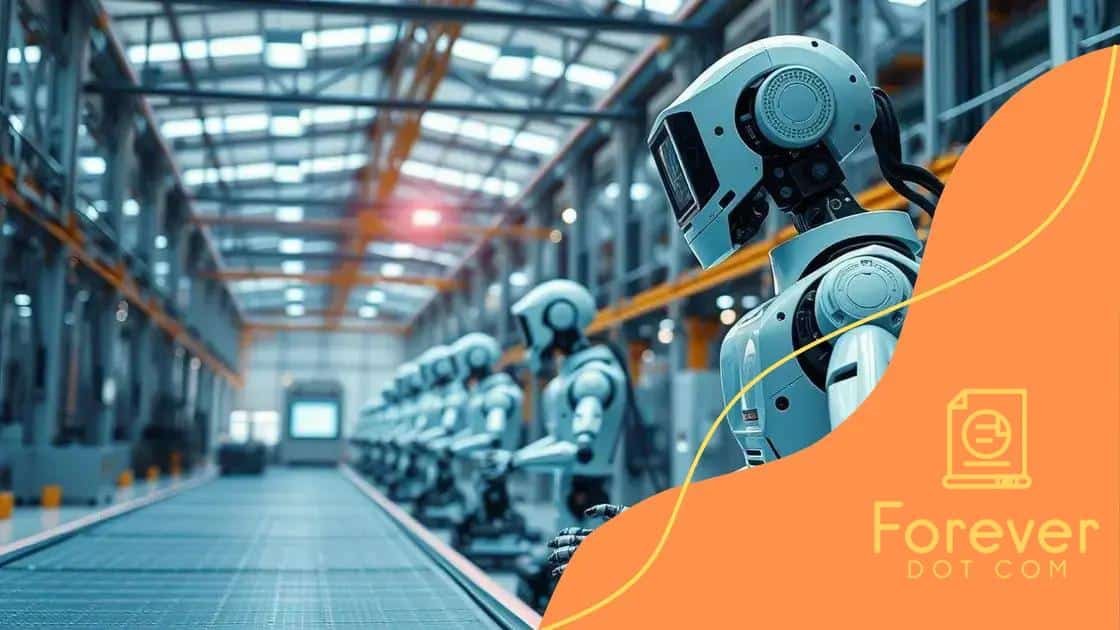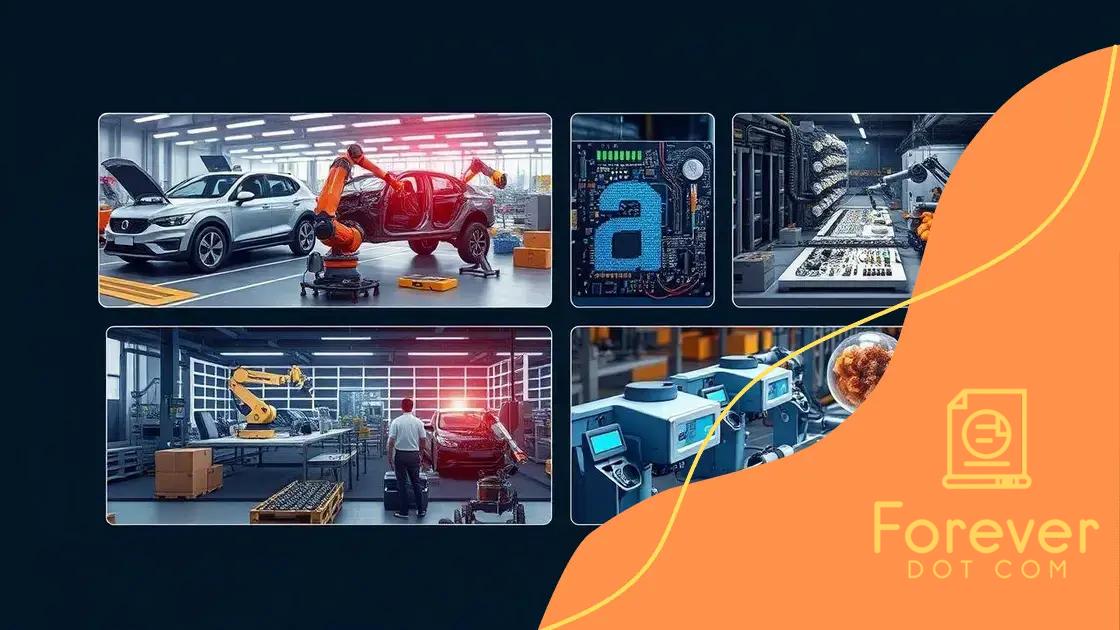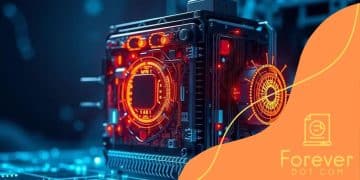AI-powered automation in the manufacturing industry

AI-powered automation in the manufacturing industry enhances efficiency, reduces costs, and improves product quality while addressing challenges such as high initial costs, integration issues, and workforce skill gaps.
AI-powered automation in the manufacturing industry is transforming how goods are produced. Ever wondered how it could improve efficiency and lower costs? Let’s dive into this intriguing topic.
Understanding AI-powered automation
Understanding AI-powered automation is crucial for anyone involved in the manufacturing sector today. This technology is redefining how factories operate, making processes faster and more efficient.
What is AI-powered Automation?
At its core, AI-powered automation refers to using artificial intelligence to streamline various tasks in manufacturing. This includes everything from assembling products to managing supply chains. By integrating AI systems, manufacturers can achieve greater accuracy and speed.
Benefits of AI-powered Automation
Implementing AI-powered automation offers several benefits:
- Increased efficiency in production processes.
- Reduction in human error.
- Cost savings over time.
- Ability to analyze data for better decision-making.
With these advantages, it’s clear why many companies are adopting this technology.
The integration of AI-powered automation is not just about replacing human workers; it’s about enhancing productivity and allowing them to focus on higher-order tasks. As machines take over repetitive jobs, employees can engage in more strategic roles.
Moreover, this technology can adapt to changing circumstances within a factory. For instance, if demand for a specific product rises, AI systems can adjust production schedules accordingly, ensuring that supply meets demand effectively.
Conclusion
In summary, understanding AI-powered automation helps manufacturers realize its potential benefits and streamline their operations. As the industry evolves, so will the opportunities for enhanced efficiency and productivity.
Key benefits for manufacturers
Understanding the key benefits for manufacturers when implementing AI-powered automation is essential for gaining a competitive edge. These advantages go beyond simple efficiency gains; they transform entire production processes.
Enhanced Efficiency
One of the most significant benefits is increased efficiency in manufacturing operations. With AI systems in place, factories can perform tasks faster and more accurately than ever before.
- Reduction of production time.
- Minimization of errors during the manufacturing process.
- Faster response times to market demand.
By optimizing these aspects, manufacturers can create more products while keeping costs down.
Cost Reduction
Cost savings are another critical benefit of adopting AI-powered automation. Although the initial investment might be substantial, the long-term savings can be significant.
AI can efficiently manage inventories, leading to less waste and better resource allocation. For example, precise demand forecasting helps avoid overproduction, which can tie up capital unnecessarily.
In addition to inventory management, labor costs can be reduced as tasks become streamlined through automation. Companies are able to allocate human resources to more strategic roles instead of repetitive tasks.
Informed Decision-Making
Moreover, AI-powered automation provides valuable data analytics that help manufacturers make informed decisions. By analyzing production metrics in real-time, organizations can identify trends and issues before they escalate.
This capability allows for proactive management of production lines and enhances overall quality control. With better insights, manufacturers can refine their processes regularly.
Real-world applications in production

Exploring the real-world applications in production of AI-powered automation reveals how diverse industries adopt this technology to enhance their operations. From automotive to electronics, manufacturers are leveraging AI to drive innovation.
Automation in the Automotive Industry
The automotive sector is one of the earliest adopters of AI-powered automation. Factories use robotic arms for assembly lines, increasing precision and speed. For instance, robots can weld and paint vehicles with high accuracy, significantly reducing cycle times.
- Improved assembly line efficiency.
- Reduction of human error in critical tasks.
- Seamless integration of new models into production.
This has allowed manufacturers to respond quickly to market demands and customize vehicles more efficiently.
Electronics Manufacturing
In electronics manufacturing, AI automates the inspection process, ensuring high-quality standards. Machines equipped with machine learning algorithms can detect defects in components, something that was previously reliant on human inspectors.
The integration of AI-powered automation in electronics leads to faster production timelines and higher quality products. This can result in fewer returns and higher customer satisfaction.
Food and Beverage Industry
The food and beverage industry also benefits from automation. Processing plants use AI to monitor and control production processes, enhancing food safety and consistency.
AI systems can analyze data from various stages of production to optimize ingredient mixes and reduce waste. This not only improves sustainability but also ensures that products meet safety regulations.
Overall, the real-world applications of AI-powered automation demonstrate its versatility and effectiveness across various sectors. Manufacturers can achieve greater productivity and innovation while responding swiftly to changing consumer preferences.
Challenges manufacturers face
While there are many benefits to AI-powered automation, manufacturers also face several challenges when integrating this technology into their operations. Understanding these hurdles is crucial for successful implementation.
High Initial Costs
One of the primary challenges is the high initial costs associated with setting up AI systems. Investing in advanced technology, hardware, and training can be expensive. Many companies may hesitate to spend significantly on automation, mainly if they are unsure of the return on investment.
- Costs include software development and installation.
- Training staff to operate complex AI systems.
- Ongoing maintenance expenses.
These upfront investments can deter smaller manufacturers from adopting AI-powered solutions.
Integration with Existing Systems
Another challenge is the integration of AI-powered automation with existing production systems. Many factories have legacy equipment that may not support modern AI technologies. This can lead to compatibility issues, requiring potential upgrades or complete overhauls.
To address integration challenges, manufacturers need to assess their current systems and determine what needs updating. This process can be time-consuming and may disrupt ongoing production.
Training and Skill Gap
The skill gap in the workforce poses another significant challenge. Employees may lack the necessary skills to engage with AI technologies effectively. This gap can hinder the full realization of the benefits of automation.
Manufacturers must invest in training programs to upskill their workforce. This helps ensure employees can operate AI tools and understand data analysis. Without adequate training, the implementation of AI may not achieve its full potential.
Overall, while AI-powered automation offers numerous benefits, manufacturers must navigate these challenges to succeed. By addressing initial costs, integration complexities, and workforce skills, companies can better position themselves to embrace automation effectively.
Future trends in manufacturing automation
Looking ahead, the future trends in manufacturing automation are set to reshape the industry significantly. As technology evolves, manufacturers must keep pace with these changes to stay competitive.
Increased Use of AI and Machine Learning
One major trend is the increased use of AI and machine learning in production processes. These technologies are becoming more sophisticated, enabling machines to learn from data and improve their efficiency over time.
- Predictive maintenance to reduce downtime.
- Smart factories that adapt to real-time data.
- Enhanced quality control through AI-driven inspections.
This means that manufacturers will rely more on data-driven insights to optimize production.
Internet of Things (IoT) Integration
The integration of the Internet of Things (IoT) is another prominent trend. Connected devices can communicate and share data, creating a smarter and more efficient manufacturing environment. For instance, sensors on machines can monitor performance and send alerts when maintenance is needed.
This connectivity allows companies to streamline operations and respond to issues quickly, minimizing disruptions. Furthermore, IoT can enhance supply chain visibility, helping manufacturers better manage their resources.
Collaborative Robotics (Cobots)
Another exciting development is the rise of collaborative robotics, or cobots. These robots work alongside humans, assisting with repetitive tasks and allowing employees to focus on more complex activities. Cobots are designed to be safe and easy to program, making them accessible for various manufacturing environments.
This trend promotes a more flexible workforce where humans and machines work together effectively. It also helps companies to increase productivity without the need for extensive retraining of employees.
Embracing these future trends in manufacturing automation will be essential for companies looking to maintain a competitive edge. As technology continues to advance, staying informed and adaptable will be key to success.
FAQ – Frequently Asked Questions about AI-powered Automation in Manufacturing
What are the primary benefits of AI-powered automation in manufacturing?
AI-powered automation enhances efficiency, reduces costs, and improves product quality by streamlining production processes.
What challenges do manufacturers face when implementing AI automation?
Common challenges include high initial costs, the need for integration with existing systems, and skill gaps in the workforce.
How does IoT contribute to manufacturing automation?
IoT connects devices, enabling real-time data sharing that improves efficiency, monitoring, and overall production processes.
What future trends should manufacturers be aware of?
Key trends include increased AI usage, IoT integration, and the adoption of collaborative robots that work alongside human employees.






